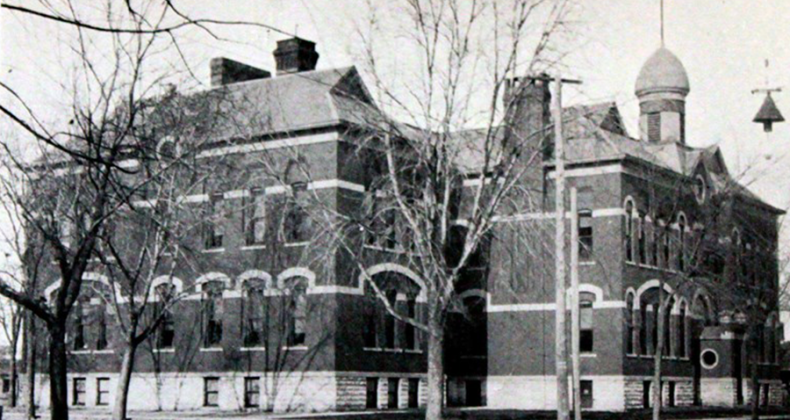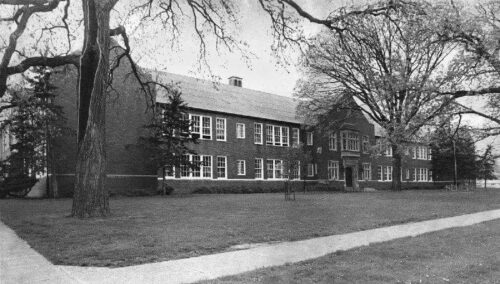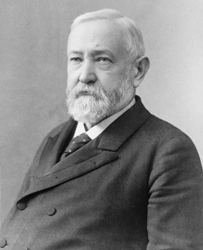
The History of Harrison Elementary begins in 1876. The school actually began as Hull School, named for a donor who discovered more than 50 children between the ages of 5 and 14 in the Time Check neighborhood who had never attended school and offered to donate a school for them if the school district would supply a teacher. The Board of Education accepted Mr. Hull’s proposition, and on October 2, 1876, the one-room Hull School was opened to students, with Miss Belle Byers as the teacher. It was located near K Avenue and Sixth Street West. Nearly 10 years later, a larger building went up on the same site. This school had eight rooms. It was named for William Henry Harrison, the ninth president of the United States. The first PTA at Harrison School—or Mother’s Club, as it was called then—was organized in the spring of 1900. On March 15, 1910, the group reorganized and became an official parent teacher association, the first one in Cedar Rapids, Iowa. In 1902 and 1917, additions were added to the building. During the 1908-1909 school year the school housed kindergarten to eighth grade students.
The building was located where the Flamingo Restaurant is now. It was named after the ninth president of the United States, William Henry Harrison.

Tragedy struck the building on Monday, January 28, 1929, when a fire of unknown origin destroyed the school. A mural that Grant Wood had painted for Harrison School was destroyed in the fire. Other items lost included dozens of small animals used for science class studies, a unique collection of butterflies and other insects, and a spinning wheel that had belonged to the great-great-grandmother of Miss Marjorie Walters, the principal of Harrison from 1920 until 1952. For the next eighteen months 561 children in this area attended school in churches and in basements of other schools.
The building was built in an English Tudor style. The front of the building is 250 feet and six inches across. It is about 90 feet in depth. The building is two stories high. It has a separate heating plant, 44 by 35 feet, at the rear of the main building. The hallway of each floor has corridors 13 feet wide. For its day the building was considered one with the latest conveniences and modern equipment. The building had some lead glass windows. Each classroom had “two toilets, its own drinking fountain, cloak room, and large oak cabinets for teachers to store materials.” The oak cabinets each had an electrical plug so teachers could use a “daytime lantern” in their classrooms, if they so wished. The school was said to have been built “to last half a century, at least.”
Original costs of Harrison Elementary School
| Item | Cost |
|---|---|
| John B. Emery, site | $8,250.00 |
| O.F. Paulson Construc’n Co., general contract | $176,741.63 |
| Wheatland Co., Inc., heating & ventilating cont. | $32,700.00 |
| Cyrus Metcalf Co., plumbing contract | $11,660.25 |
| H.E. Hunter, architect | $9,108.97 |
| O.L. Leefers, clerk-of-the-works | $4,786.62 |
| Kutchera & Sons, sodding | $337.50 |
| County Treasurer, curbing | $1,795.42 |
| Furniture and equipment | $12,473.40 |
| Total cost | $264,238.79 |

The new school was built solely as an elementary school, unlike many schools of that time. It was to house only kindergarten through sixth grades.
The school was officially dedicated on November 7, 1930. During the dedication ceremonies, behind the cornerstone bearing the date of 1929, a copper box was placed containing newspapers and other publications from 1929, Cedar Rapids telephone directory, photographs of the old Harrison School before and after the fire, a picture of the new school under construction, and a list of Harrison students. To our knowledge no one has opened this dedication box.
The new Harrison School was named for Benjamin Harrison, the 23rd president of the United States and his grandfather, William Henry Harrison, the ninth president of the United States.

When the new school was 60 years old, there was a celebration commemorating the 1930s dedication. Staff and students who had attended Harrison Elementary School came. A 1930s-style classroom was recreated on the stage of the gymnasium.
During the celebration, another box was capsulated. It was put in a compartment built into the wall at the east corner of the south wall of the gymnasium. The box contains a video of the celebration, the article from the Cedar Rapids Gazette which tells about the “60 Years of Dedication” celebration, and information about the earlier Harrison school, as well as other miscellaneous information.
In 1987, Fred Steitzer, principal from 1986 to 1990, and Ethel McCreedy, secretary, played an important role in arranging to have the oak cabinets and school’s woodwork refinished. They polished hundreds of sets of brass door hardware. More than 48 leaded-glass window panes were repaired, one pane at a time. Steitzer also discovered 22 framed prints, most dated in the late 1890s, in the tunnels beneath the school. He had the frames and the prints restored and today the prints are located at the district offices.
In the main foyer there now hangs a 23-foot long mural that was painted in 1934 by William Henning, an artist who once worked with Grant Wood. The mural is 23-feet long and is titled “Transportation.” More information about this painting is printed below.
Our school today looks almost exactly like it did in the 1930s. However, there are some changes. A five-room kindergarten and first grade wing was added in 1955. There are now 25 classrooms including those that were built on. In 1995, a double portable building was added to the grounds. That classroom, called Berkeley Place, was placed at the northwest corner of the main school. It is used for two classrooms. In 2016, a community recreation center was built next to Harrison partnered with the City of Cedar Rapids and Cedar Rapids Community School District. The students of Harrison use this center for recreation activities throughout the school year.
Transportation, a mural by William E. Henning
In 1934, Cedar Rapids Community School District was looking for someone to paint a mural in their newly built Harrison Elementary School. Grant Wood had painted a work of art for the older Harrison School which had been destroyed by fire in 1928. When Wood was approached about doing a painting for the newly built school, he recommended William E. Henning. Henning was just 23 years old, but had already worked with Grant Wood under the Public Works of Art Program, one of the New Deal’s various federally-funded projects.
The mural was to be 22-feet by five feet and would depict the history of transportation, from Indian canoes and horse-drawn buggies to steamships and autogiros—contraptions resembling today’s helicopters. Henning consulted with his friend Grant Wood and asked children for their ideas before selecting the transportation theme for the mural. Henning created a sketch and then he painted it. He worked in a portable classroom at Polk School. It took him nine months to complete the mural.
In 1939, a letter from Mr. Henning was published in the Iowa Journal of History and Politics, Vol. 37, No. 3 (July 1939). Although much of the letter is a technical discussion of mural painting techniques, the first few paragraphs provide a good idea of the process Mr. Henning followed to design and paint the mural.
The painting was hung in an upper hallway for over fifty years. In 1973, Henning touched up the mural before he left Cedar Rapids to retire in Washington state. In 1984, the Harrison PTA asked Henning to return to Cedar Rapids to repair some damage to the painting. At that time the mural was moved downstairs to the hallway in the main foyer area. The mural was so large that the only way the mural could be moved was to take it out the windows on the second floor and then to hoist it to ground level and bring it straight in through a doorway leading directly to the hall where it would be placed. The painting has been hanging in the Harrison School for 65 years. The colors have darkened in the painting and some of the details of the painting have been obliterated by the aging. Most people who view the mural recognize the strong influence of Henning’s friend and mentor, Grant Wood. Photographs of the mural have been included in national tours of Grant Wood’s work and the work itself has been featured on a public television special focusing on art works in public buildings.

Harrison principals
| Principal | Years |
|---|---|
| Marjorie Walters | 1920-1952 |
| Ray Churchill | 1952-1961 |
| Tony Deeb | 1961-1965 |
| Abraham Oglanian | 1965-1968 |
| Bill Brousard | 1968-1972 |
| Carl E. Carson | 1972-1974 |
| Frank Schneider | 1974-1986 |
| Fred Steitzer | 1986-1992 |
| Gregg Petersen | 1992-1997 |
| Joyce Fowler | 1997-2009 |
| Linda Reysack | 2010-2013 |
| Amy Russell | 2013-2016 |
| Trista Manternach | 2016-present |
